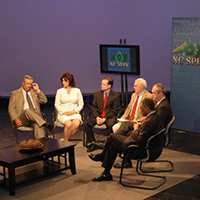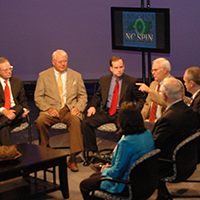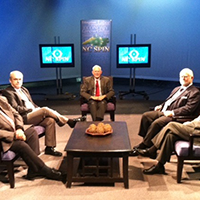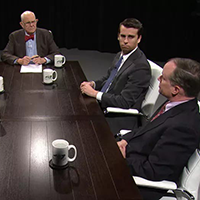North Carolina's rural anger
Published May 8, 2025
The most influential force shaping the dynamics of North Carolina politics is white, rural anger. State politics are dominated by rural white men. And the virulent tone of these men’s politics draws is force from the resentments that thousands of rural whites harbor against social forces that they believe have disenfranchised them. Their desire to strike back against liberal elites is the emotional engine of our state’s conservative bloc.
The decline of rural North Carolina represents the disruption of a centuries-old cultural settlement. That’s because the depth of our rural roots is hard to overstate. When the modern political era began around 1900, North Carolina was 90% rural. The state capital, Raleigh, had only 10,000 residents and ended at the modern-day location of Memorial Auditorium, tucked deep in the heart of today’s city. Even the state’s rapid industrialization left our state only 19% urban by 1930.
But rural North Carolina now faces existential challenges. The economic changes of the last 30 years, like the decline of rural mainstays from textile manufacturing to tobacco, have devastated our state’s rural communities. North Carolina lost 42% of its manufacturing base in the second Bush administration—a crippling blow to the small towns where most light manufacturing plants in the state were located. The 2008 financial meltdown dealt another blow to the state’s economy. And unlike the Charlotte area, which felt significant short-term pain due to job losses in the financial sector, rural areas largely have not recovered. Fifty-one counties lost population in the 2010s.
These economic hardships have formed the basis of many wrenching social challenges. In Scotland County, for example, the child poverty rate is an astonishing 49%. (Republicans worsened this deprivation in 2015 by cutting 33,000 children off of food stamps.) Poor educational attainment is another crippling burden on rural North Carolina. In many counties throughout northeastern North Carolina, the high-school dropout rate is as high as 40%. Only 11% of Anson County residents have college degrees. By contrast, the Durham-Chapel Hill metropolitan area (as defined by the Office of Management and Budget) enjoys one of the highest college-attainment rates in the country.
As these communities have declined, rural NC has lost some of its centrality to North Carolina life. After centuries of rurality, NC is now a 60% urban state. The Charlotte area has about 3,000,000,000 residents, and the Research Triangle has 2.3 million. Asheville is a renowned tourist destination. And while less affluent than Raleigh and Charlotte, the Triad contains well over 1 million people and continues to attract new transplants, especially African Americans.
Rural NC is plainly in decline. Hence: bitterness. But our state’s rural character is so deeply ingrained that many Republicans earnestly think of their districts, as Sarah Palin might've put it, as the “real" North Carolina. North Carolina, they believe, belongs to its countryside, not the city. Yankees, they say, are trying to steal our Dixie birthright by moving to cities that increasingly resemble the mid-Atlantic. This directionless, blood-boiling rage is what haunts - and fuels - the NCGOP’s id.
Their anger rests on a two-pronged psychology. Cognitive scientists have found that people react far more intensely to losing what they have than to gaining what they do not have yet. This is called “loss aversion.” They judge the value of what they have—or what they’re losing—based upon what social psychologists call “reference groups.”
The decline of rural North Carolina represents the disruption of a centuries-old cultural settlement. That’s because the depth of our rural roots is hard to overstate. When the modern political era began around 1900, North Carolina was 90% rural. The state capital, Raleigh, had only 10,000 residents and ended at the modern-day location of Memorial Auditorium, tucked deep in the heart of today’s city. Even the state’s rapid industrialization left our state only 19% urban by 1930.
But rural North Carolina now faces existential challenges. The economic changes of the last 30 years, like the decline of rural mainstays from textile manufacturing to tobacco, have devastated our state’s rural communities. North Carolina lost 42% of its manufacturing base in the second Bush administration—a crippling blow to the small towns where most light manufacturing plants in the state were located. The 2008 financial meltdown dealt another blow to the state’s economy. And unlike the Charlotte area, which felt significant short-term pain due to job losses in the financial sector, rural areas largely have not recovered. Fifty-one counties lost population in the 2010s.
These economic hardships have formed the basis of many wrenching social challenges. In Scotland County, for example, the child poverty rate is an astonishing 49%. (Republicans worsened this deprivation in 2015 by cutting 33,000 children off of food stamps.) Poor educational attainment is another crippling burden on rural North Carolina. In many counties throughout northeastern North Carolina, the high-school dropout rate is as high as 40%. Only 11% of Anson County residents have college degrees. By contrast, the Durham-Chapel Hill metropolitan area (as defined by the Office of Management and Budget) enjoys one of the highest college-attainment rates in the country.
As these communities have declined, rural NC has lost some of its centrality to North Carolina life. After centuries of rurality, NC is now a 60% urban state. The Charlotte area has about 3,000,000,000 residents, and the Research Triangle has 2.3 million. Asheville is a renowned tourist destination. And while less affluent than Raleigh and Charlotte, the Triad contains well over 1 million people and continues to attract new transplants, especially African Americans.
Rural NC is plainly in decline. Hence: bitterness. But our state’s rural character is so deeply ingrained that many Republicans earnestly think of their districts, as Sarah Palin might've put it, as the “real" North Carolina. North Carolina, they believe, belongs to its countryside, not the city. Yankees, they say, are trying to steal our Dixie birthright by moving to cities that increasingly resemble the mid-Atlantic. This directionless, blood-boiling rage is what haunts - and fuels - the NCGOP’s id.
Their anger rests on a two-pronged psychology. Cognitive scientists have found that people react far more intensely to losing what they have than to gaining what they do not have yet. This is called “loss aversion.” They judge the value of what they have—or what they’re losing—based upon what social psychologists call “reference groups.”
The GOP’s reference group is the rest of North Carolina, and watching urban areas supplant the old rural stock has caused a searing impression on the Republican base that goes deeper than any poll or survey can measure.
Alexander H. Jones is a Policy Analyst with Carolina Forward. He lives in Carrboro. Have feedback? Reach him at alex@carolinaforward.org.







